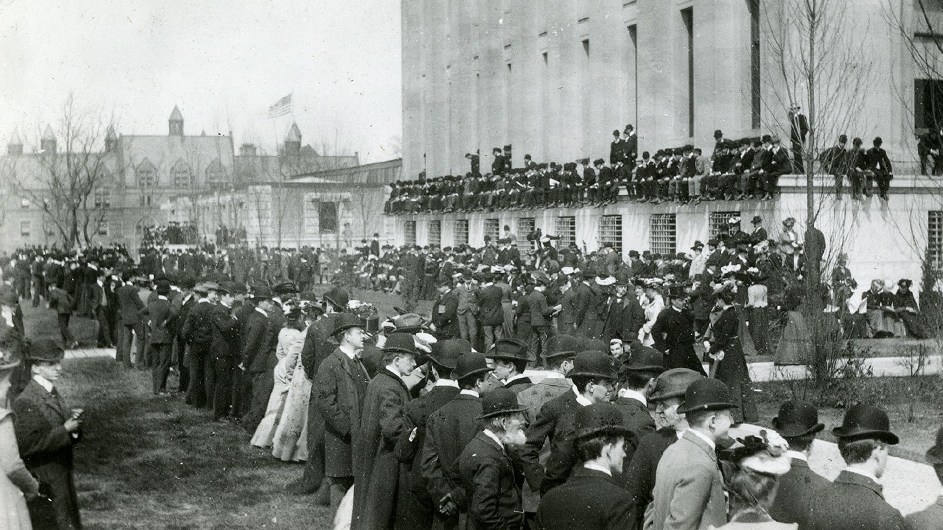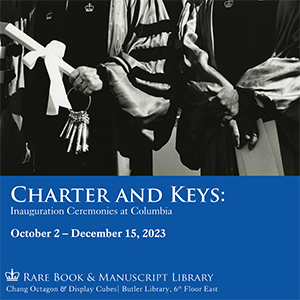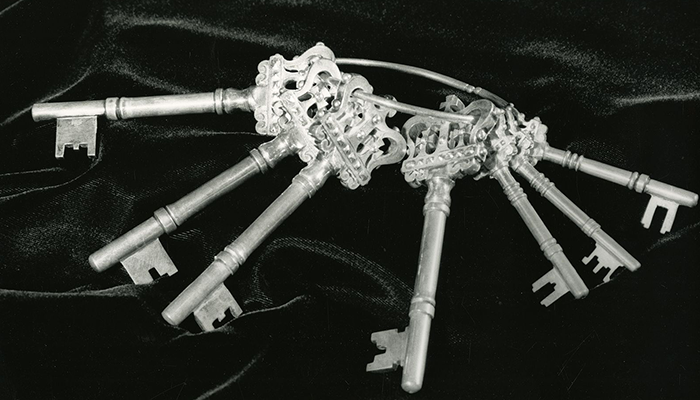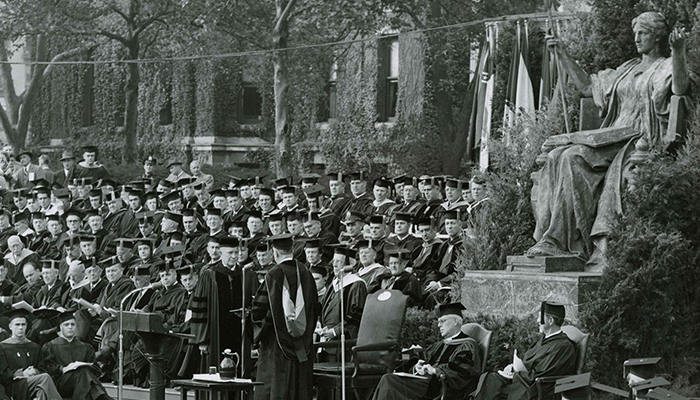Uncovering the History of Columbia’s Presidential Inaugurations
A new exhibit at the Rare Book & Manuscript Library, opening Oct. 2, sheds light on the traditions that usher in a new era at the University.

Tucked away on the sixth floor of Butler Library, you will find the Rare Book & Manuscript Library (RBML), which is home to a treasure trove of archival collections, including the University Archive, which stores the untold secrets and history of what has made Columbia University what it is today.
Among those files, photographs, and objects lies the history of Columbia's 174 years of presidential inaugurations. Ahead of President Minouche Shafik's Inauguration on Oct. 4, Jocelyn Wilk, University archivist, and Joanna Rios, records manager, were tasked with diving into the collection to find the most intriguing traditions and stories associated with inaugurations over the years.
The result? A new exhibition, opening Oct. 2 and running through Dec. 15, will take visitors through the evolution of these landmark events and prepare Columbians for the next chapter as President Shafik is formally installed as the head of the University. It is titled "Charter and Keys: Inauguration Ceremonies at Columbia."

"It's just fun and interesting history," Wilk said. "We've dug up some cool photographs that haven't seen the light of day in a really long time. We found old color slides from Sovern and Rupp's ceremonies. My colleague found an interior picture of a chapel where the 1864 ceremony was held that we didn't even know we had! You'll also find images of big names like Toni Morrison and Isaac Bashevis Singer who were a part of a symposium connected to the 1980 inauguration. It's just extraordinary."
Columbia News recently sat down with Wilk to divine some of the most fascinating history from the collection, but we'd truly recommend a visit to RBML to get the full experience. CUID holders can visit RBML Monday through Friday from 10 a.m. to 4 p.m. without an appointment. For members of the public who wish to see the exhibit, register at the Library Information Office with a government-issued photo ID to get a visitor's pass.
The Three Ceremonial Items at the Presidential Investiture Ceremony

Prior to 1849, Columbia's presidents were always installed at the annual Commencement ceremony. For President Charles King, however, the Trustees flipped the script and he was the first Columbia president to be inaugurated in a separate ceremony, held at the chapel at Columbia College's original building on Park Place. Since that time, three items have evolved to become the most recurrent items at investiture ceremonies, and you will catch a glimpse of them at President Shafik's inauguration on Oct. 4:
University Charter
"Incoming presidents received a copy of the 1754 Charter as a symbolic taking over of the responsibilities of this institution,” Wilk said. “In addition to a reproduction of the original King’s College Charter, on display in the exhibit is a volume of University charters specially bound and given to President Nicholas Murray Butler by the Trustees in 1902. In more modern times, the charter given to a new president has been text in a binder or a representative sample on a scroll. I think Michael Sovern was the first University President to have a scroll handed to him in 1980 and that tradition has continued."
Presidential Keys to the University
"The keys on display and used at this year’s ceremony only date back to Nicholas Murray Butler's inauguration in 1902," Wilk said. "It was the first ceremony on the Morningside campus, which Columbia moved to in 1897. The keys are representative of the seven new buildings that were on campus at that time."
The keys themselves will be on display in the exhibition but will be removed for a short while to be used in President Shafik's Investiture ceremony.
Benjamin Franklin Chair
"The other symbolic item that will be on the stage at the inauguration is the Benjamin Franklin Chair, which was the president's chair used in the Trustees Room for many years," Wilk said. "Before that, it was present in the chapel where F.A.P. Barnard presided over services down on 49th Street, which is pictured in the exhibition.
"Benjamin Franklin designed the chair and his family gave it to a Columbia professor who, through a few twists and turns, gave it to Columbia. It was used regularly well into the 20th century, but President Dwight D. Eisenhower was probably the last person to actually sit in the chair during the investiture ceremony. Because of its age, the Chair still takes part in the ceremony but is no longer actively used."
You can read more about the history of the chair here.
The Many Different Locations of Presidential Inaugurations

On Oct. 4, President Minouche Shafik will be inaugurated in front of Low Library (and you're invited!), but did you know that investiture ceremonies have not always taken place there? In fact, it was first held below Alma Mater on Low Steps for President Dwight D. Eisenhower's inauguration in 1948.
"Charles King was inaugurated at the original college chapel at the Park Place campus in 1849," Wilk said. "Frederick A.P. Barnard was inaugurated in the chapel at Columbia's second campus at 49th Street and Madison Avenue in Midtown. The crowd expected for Seth Low’s 1890 ceremony was so large the Trustees chose to rent a non-campus location, the nearby Metropolitan Opera House.
"Nicholas Murray Butler was installed in University Hall, where Uris Hall now stands, though you'll see pictures of people processing to that event in front of Low Library. With Eisenhower, the University moved the investiture ceremony in front of Low Library and that’s where it usually continues to be held to this day.
"There were a few other presidents inaugurated between Eisenhower and Michael Sovern and that's where we get into fun facts. In January of 1953, Eisenhower stepped down to take over the U.S. presidency, and his right-hand man and University Provost, Grayson Kirk stepped in. Kirk had no special public ceremony but was instead inaugurated at Commencement in 1953. In 1970, William McGill, during a time of fiscal strife, canceled his formal inauguration and moved the budget allocation to financial aid. It was a perfect approach for what was happening at the University at the time."
Michael Sovern and his successors, George Rupp and Lee C. Bollinger, all received the charter and keys on campus, in front of Low Library on sunny October days. You can read the full history of inauguration ceremonies here.
To learn more about the history and traditions of presidential inaugurations at Columbia, visit the Rare Book & Manuscript Library from Oct. 2 to Dec. 15, 2023 for "Charter and Keys: Inauguration Ceremonies at Columbia" in Butler Library. Keep up with the latest from RBML with their fabulous blog.